
Surfboard fins are a crucial part of your surfboard setup. Choosing fins that will work best for you and your surfboard depends on your size, riding style, and your surfboard’s fin box.
Before talking about fin size or different fin configurations, it is important to distinguish between glassed-in and removable fins.

Glassed-in fins are laminated into the surfboard. As you might imagine, a glassed-in fin might be smoother and more sound than a removable fin. However, glassed-in fins are difficult to repair and do not offer you the versatility of removable fins.
Surfboards with removable fins have “boxes” that fins are screwed into. Removable fins can be added or removed using a fin key and adjusting the small (typically stainless steel) inset screws. Don’t force your fins into the box as that may damage your board or the fin. Instead, make sure the screws are loose enough and that your fin is facing in the right direction. Center and outside fins have different shapes, so make sure you are using the right box. Once your fins are in place, tighten your screws with the key, making sure the fins are secure but not too tight.

Although longboard fin boxes are generally cross-compatible across all boards, the rest of the fin boxes out there are almost certainly equipped with one of these three box types:

These fins have two tabs that are secured to the board using set screws. FCS recently launched the FCS2 “keyless” Fin Standard, meaning fins can be installed or removed without a key or grub screws. FCS2 is also backwards compatible, meaning you can use your twin tab FCS fins with the new FCS2 system. Set screws are required. (All of our twin tab fins come with screws)

The other fin box, Futures Fins, connect to your board using a Truss Base along the entire length of the fin box (unlike plugs) for a strong, lightweight connection. Quick and easy set screws hold the fins in place.

The following chart is Captain Fin’s recommended fin size according to rider weight. If you are between sizes, consider the type of board and/or type of waves you will be riding with that particular setup. For example, if you are in between size Medium and Large, you might pick size Medium fins for your small wave board, but size Large fins for you big wave board.
 |
 |
| GROM | UP TO 115 |
| SMALL | UP TO 155 |
| MEDIUM | 140-190 |
| LARGE | 175+ |

Once you’ve decide on your fin size, you need to understand your board’s fin configuration. To determine your fin configuration, examine the base of your surfboard near the tail. The number of fin boxes you see is the fin configuration and will likely range from 1 to 5. The most common surfboard fin setups are Single, Twin, Thruster, and Quad. Many boards are now equipped with 5 Fin boxes so you can mix and match more easily. There are also many boards offered with a longboard single fin box and regular side fin boxes called 2+1.

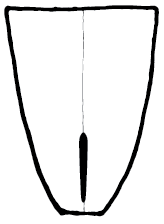
|
A single fin box is most common on longboards and is the most traditional fin configuration. Turning with a single fin is limited, meaning single fins are ideal for fast, straight shot surfing. Single fins will provide stability, control, and predictability to your longboard. Longboard single fin boxes are long and allow you to move the fin forward for a looser feel, or further back for more control. |

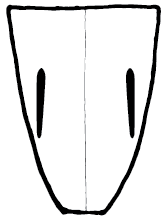 |
The Twin Fin configuration will make your surfboard fun, playful, and maneuverable. Twin fin setups are ideal for your shortboard fish and can even be fun in bigger waves. Twin fins offer a skatier feel and longer, more drawn out turns. |

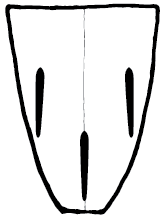 |
These days, 3 fin setups are the most common configuration and can be found on a variety of surfboard shapes and sizes. The two outer fins are closer to the middle of the board, angled towards the board center (”toed-in”) and can be flat on the inside in order to increase water tracking and speed. The center fin is closest to the tail and is symmetric on both sides for stability (see Foil for more info). Tri-fins perform well because they add stability, control and maneuverability that beginners and pros excel on. |

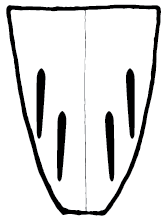
|
Quad fin configurations offer speed in smaller surf by channeling the water to the end of the surfboard and out the tail for acceleration. Two fins near the rails of your surfboard will also add stability and hold in big-wave surfing. Lastly, quad fins are great for generating drive through turns. |

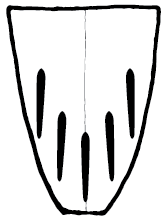
|
Five fin configurations are not meant to be surfed with all five fins. Five fin boxes allow you to mix and match fins depending on your preference and the surf conditions. Swap from the freedom of a twin fin, to the traction of a thruster, to the speed of a quad without changing boards. |

The Sweep, toe, Base Length, Foil, Flex, Height and Cant are important measurements of every surfboard fin, and should be considered when choosing your next surf fins.


|
The sweep, or rake, is how far the front edge of a fin arcs backwards. Rake or sweep angle is a measurement that determines how far back the fin curves in relation to its base. Fins with a small rake (large offset) help propel the board, are very stable and predictable but are not ideal for making sharp fast turns. On the other hand, fins with a large rake angle and a small offset will allow your board to have a tighter turning radius, but are more “squirrelly” and playful. |

 |
The toe or splay of a surf fin is defined as the angle of the side fins in relation to the board’s stringer. Side fins are typically referred to as “toed-in”, with the front of the fin angled towards the middle of the board. This causes water to pressure the outside of the fins, for increased responsiveness. |


|
The base length of the fin is the widest point of the fin, and sits flush with the board once installed. This length can affect how the board will respond to turns. Longer fin bases create trajectories for water to go past - so your surfboard will move faster. If you want to make sharp turns, however, look for a shorter fin base length. |

 |
Foil refers to the shape of the outside and inside faces of your fin, thinnest near the tip and thicker near the base. Foil alters the flow of the water over the fin surface and has a direct impact on the performance of your fins and board. Middle fins are always symmetrical and convex on both sides (50/50) for even distribution and stability, while outside fins are usually convex on the outside face and flat or curved on the inside. A flat inside face creates a solid balance of control, speed, and playfulness, while a curved or concave inside face maximizes lift with minimal drag, ideal for speed generation and fluidity. |

 |
The flexibility of a fin, or lack thereof, can significantly affect the way a surfboard rides. In general, a flexier fin will provide a skatier feel on more playful waves, but a stiff fin is ideal in faster more hallow waves. It is important to note that high end fins can be both soft and stiff - they have flex patterns. Many fins now have a stiffer base for tracking and stability, with a softer tip that make it easier to break your board loose while turning. As a rule of thumb, stiffer fins work well for all ability levels; they are forgiving, stable and predictable, creating a solid platform for progression and big wave riding alike. Soft and flexible fins are great for making fast, sharp turns and will give free surfers a lively feel to their boards, but are more difficult to control compared to stiff fins. |

 |
The height is measured from the base of the fin to the tallest point of the fin. This measurement can change your board’s stability and grip through turns. For surfers who desire a board that is easy to control, a taller fin will be more forgiving and handle turns in a relaxing manner. Shorter fins do not grip the water as well, but rather allow the board to be more buttery when turning, ideal for spin-like maneuvers on the water, for example. |

 |
Cant is the tilt of the fin in degrees, in relation to the base of your surfboard. For example, a fin that is straight up in the fin box has no cant (90°) and will likely make your ride faster, while anything more than 90° will increase responsiveness. In order to enhance rider-to-board connectivity and responsiveness, especially through turns, you will benefit from canted fins. The less cant a fin has the more drive and acceleration your board will have but will also be less playful. In turn, the more cant a fin has the looser and more maneuverable your surfboard will feel. |

That’s a lot of information...so what fin is best for you? The best way to know what fin is best for you and the waves you surf is to try different sets. Just like test driving a car, you should test drive fins in a variety of configurations and types.
